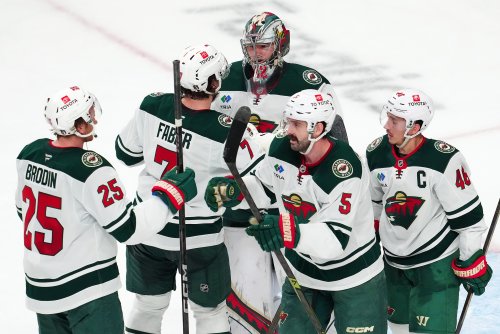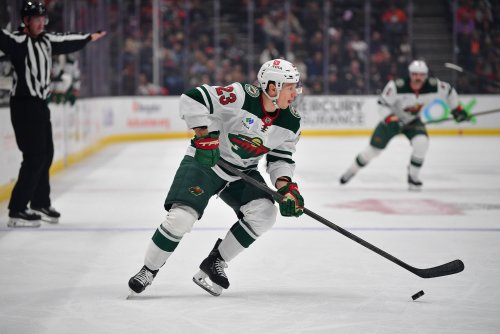
Being an NHL head coach requires you to take on multiple roles. The best coaches juggle numerous responsibilities, from strategies to tactics to locker-room leadership. Balancing the needs of all 23 players in a locker room can be difficult. But perhaps above all, handling young players and properly developing them is essential for a coach. The inability to do so can doom an organization's future.
John Hynes has had the opportunity to coach many top picks over his coaching tenure. Hynes has coached young players with the New Jersey Devils and Nashville Predators, and they haven’t always turned into stars with him behind the bench. Not only that, some of these former top picks either found success on different teams or were more productive after Hynes was relieved from his duties.
Below are three specific examples of prospects who thrived after Hynes departed.
Hockey Wilderness looked into how Hynes handled Jack Hughes during their brief time together. However, players as talented as Hughes occasionally thrive regardless of their situation. Still, that’s not to say there were no gripes from the fanbase.
“The coaching situation does not work, and that’s as clear as ever today. Looking at the decisions made before the game and in the game against the Pittsburgh Penguins, it’s clear something isn’t clicking,” wrote Nick Villano of Pucks and Pitchforks, a Fansided Devils site. “Head coach John Hynes put his most talented player Jack Hughes with a young player trying to find his way in Jesper Boqvist and a veteran who’s lost two steps in Wayne Simmonds.”
But Hughes isn’t the best example from New Jersey, though. When Hynes took over, Kyle Palmeri and Adam Henrique were New Jersey’s leading scorers. They are not bad players by any stretch of the imagination, but they are not exactly players you want to build a franchise around.
Due to their subpar play on the ice (28-40-14), the Devils landed the first overall pick in 2017 and selected Swiss superstar Nico Hischier. At the time, New Jersey was almost devoid of talent outside Taylor Hall and Hischier. In a developmental 2017-18 season, Hynes gave Hischier the second-most minutes among forwards. That led to Hischier having a successful rookie year, playing all 82 games while notching 20 goals in a 52-point campaign.
While that’s great, a downward trend in Hischier’s point totals showed it was hard for the young center to build off of his rookie success. Instead of getting better, his progress stagnated. In his sophomore season, Hischier led the forwards in time on ice per game but saw only a marginal increase in his point-per-game totals (0.63 as a rookie to 0.68).
Most damningly, In his third season, Hischier was far and away the team leader in ice time per game. Hynes put him on the top powerplay unit, the top line, giving him all the prime opportunities you’d like to see. Despite all that, his point-per-game totals dropped to his rookie level of 0.63 points per game (15 points in 24 games before Hynes’ dismissal).
Now, does this lack of growth from Hischier fall on Hynes’s shoulders? Maybe not. But after injury-hampered 2019-20, the year New Jersey fired Hynes, and 2020-21 seasons, he exploded with 21 goals and 60 points in 70 games. Since that season, Hischier has scored over 30 goals and reached 80 points. The Switzerland-born forward is finally reaching his full potential.
While the Hischier case may have just been a young player working through the game, Hynes's time in Nashville is a different story.
Eeli Tolvanen is the first example that comes to mind. Nashville’s first-round pick was a KHL star but struggled to find any traction after making his full-time NHL debut during the 2020-21 season.
Tolvanen didn’t exactly deliver on the hype upon his arrival to the NHL. Tolvanen put up historic numbers as an 18-year-old in the KHL. Tolvanen had the best season ever for an 18-year-old playing in the KHL. Yes, that means it’s better than Kirill Kaprizov, Evgeny Kuznetsov, and Artemi Panarin. Tolvanen’s 36 points in 49 games is four points better than the fella in second.
He played in 40 games and recorded 11 goals and 22 points in his first season. Still, Tolvanen was putting up a positive Corsi For % while only playing 12 minutes a night. Not all bad for a rookie.
In Tolvanen’s second season, he failed to improve all that much. He got 25 more games and produced just one more point than his rookie season. It was an incredibly disappointing performance from a player for whom the organization had high hopes. The stagnation was astounding. Hynes had Tolvanen producing on the powerplay (12 of his 23 points) but struggling mightily at even strength while his ice time fluctuated all year.
Tolvanen started the next season on a cold streak that ended up with the Predators putting him on waivers after just 13 games. The Seattle Kraken claimed him, and he’s looked more like the player Nashville thought they were getting when they drafted him since then. Tolvanen put up 16 goals and 27 points in 48 games with Seattle last season and has 16 points in 24 games this year.
Notably, his point total would be tied for third on the Predators this year, behind Filip Forsberg and Ryan O’Reilly. One year later, the Predators have neither Tolvanen nor the coach who was in place when Nashville waived him. Ann Kimmel of The Hockey News had some choice words about the situation in a May 31 article:
“The lack of clarity on Tolvanen's role was frustrating to a fan base who had been waiting to see this particular player become an NHL staple in Nashville,” Kimmel explained. “[Tolvanen] never found the niche spot that he eventually found success in with Seattle.” Reminiscent of what happened with Calen Addison in Minnesota, it seems like the focus was more on making Tolvanen a different player rather than playing to his strengths.
While Seattle could rehabilitate Tolvanen’s value, Hynes could not do the same for former sixth-overall pick Cody Glass. Nashville got the smart, skilled 22-year-old post-hype prospect in the Ryan Ellis trade. But despite Glass’ talent, his development seemed to have faltered under Hynes.
It wasn’t like Glass wasn’t an elite scorer in juniors and the AHL, as he has 22 goals and 79 points over 88 career AHL games. Still, he hasn’t entirely found his footing in the NHL thus far. This story of Hynes and Glass rings eerily similar to that of the Wild organization and Marco Rossi.
Dean Evason was able to give Rossi the promotion he deserved, and the Wild are reaping the benefits of that decision. When Glass got that shot in the 2022-23 season, though, his 14-goal, 35-point season felt underwhelming. There was the sense that Hynes left a lot on the table, as Nick Morgan of On The Forecheck illustrated:
“There seems to be a frequent discrepancy between Glass’s talents and the ‘identity’ Hynes wants him to embody,” Morgan dishes. “The downside of that is that it leaves players like Glass (and Tolvanen) pigeon-holed. More often than not lately, Glass has been relegated to the press box simply because his style of play doesn’t fit what Hynes wants from his depth lines.”
Glass’s situation was not an isolated incident, either. Instead, close observers of the Predators repeatedly criticized Hynes’ difficulty managing and dealing with younger players.
“Hynes’ coaching style matches way better with a veteran-laden team that plays a staunch defensive style,” Chad Minton of Pred Lines said. “Maybe there’s a team out there that Hynes can make that work with, but the new-look Predators isn’t that team, clearly.”
Huh, a veteran-laden team that plays a staunch defensive style. Doesn’t that sound like the Wild team we know and love? That’s maybe fine for this year, but what about next year and beyond?
Hynes’ failures in developing these young players in his past roles are a concern because of the incoming wave of Wild prospects. Minnesota has a plethora of young players and prospects who will be looking to carve out NHL jobs soon. Danila Yurov, Marat Khusnutdinov, Liam Öhgren, Riley Heidt, Daemon Hunt, Carson Lambos, and Adam Beckman are just a few that could be named who are going to be knocking on the door of the NHL in the coming years.
Bill Guerin indicated that his new head coach will be sticking around for a while, and the numerous veterans on long-term deals with no-move clauses will leave little open spots for young players and prospects to make their way onto the roster. They will likely have to fight their way onto the roster in bottom-six roles like Tolvanen, and Glass had to in Nashville.
Glass has defended Hynes, saying that “he did wonders for my game.” Hynes was able to connect with his players on a personal level. That does not mean it would turn out positively when they stepped on the ice. A personal connection is great, but the eye test also speaks volumes.
These examples of young players struggling under the watchful eye of Hynes do not guarantee Minnesota will suffer the same fate. Hynes seems to have a particular style, and the Wild seem to draft with that sort of style in mind.
But how he’s dealt with young players in the past presents a worry that Hynes’s coaching philosophy is incompatible with a youth movement. A lot can and will change with the Wild in the next couple of seasons, but it won’t be the coach. Hynes needs to adjust how he develops prospects or risk keeping the Wild trapped in their perpetual cycle of mediocrity.
All stats and data via HockeyDB, Evolving Hockey, and CapFriendly unless otherwise noted.
Think you could write a story like this? Hockey Wilderness wants you to develop your voice, find an audience, and we'll pay you to do it. Just fill out this form.
-
 1
1








Recommended Comments
Join the conversation
You can post now and register later. If you have an account, sign in now to post with your account.
Note: Your post will require moderator approval before it will be visible.